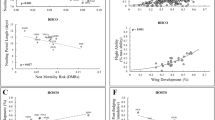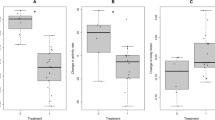Abstract
Maternally inherited bacterial endosymbionts can kill male embryos of their arthropod hosts to enhance the transmission efficiency of the endosymbionts. The resources from killed male eggs can be reallocated to infected female hatchlings as additional maternal investment. As a result, the number of offspring per patch and the maternal investment per offspring are expected to differ from the original optimal values for the host mother. Thus, in response to infection, these trait values should be adjusted to maximize the lifetime reproductive success of host females and the fitness of inherited endosymbionts as well. Here, we examined clutch size, egg size, and the proportion of trophic eggs (i.e., production of unhatched eggs, a maternal phenotype) per clutch of host mothers infected with male-killing bacteria. First, we developed a mathematical model to predict the optimal clutch size and trophic egg proportion in uninfected and infected females. Next, we experimentally compared these life-history traits in a ladybird, Harmonia yedoensis, between females infected or uninfected with male-killing Spiroplasma bacteria. Consistent with our predictions, clutch size was larger, egg size was smaller, and trophic egg proportion was lower in infected H. yedoensis females, compared with uninfected females. To our knowledge, this is the first empirical demonstration of variation in these life-history traits depending on infection with bacterial endosymbionts.




Similar content being viewed by others
References
Baba N, Hironaka M, Hosokawa T et al (2011) Trophic eggs compensate for poor offspring feeding capacity in a subsocial burrower bug. Biol Lett 7:194–196
Bandi C, Dunn AM, Hurst GD et al (2001) Inherited microorganisms, sex-specific virulence and reproductive parasitism. Trends Parasitol 17:88–94
Bian G, Xu Y, Lu P et al (2010) The endosymbiotic bacterium Wolbachia induces resistance to dengue virus in Aedes aegypti. PLoS Pathog 6:e1000833
Brownlie JC, Cass BN, Riegler M et al (2009) Evidence for metabolic provisioning by a common invertebrate endosymbiont, Wolbachia pipientis, during periods of nutritional stress. PLoS Pathog 5:e1000368
Brumin M, Kontsedalov S, Ghanim M (2011) Rickettsia influences thermotolerance in the whitefly Bemisia tabaci B biotype. Insect Sci 18:57–66
Crespi BJ (1992) Cannibalism and trophic egg in subsocial and eusocial insects. In: Elgar MA, Crespi BJ (eds) Cannibalism: ecology and evolution among diverse taxa. Oxford University Press, New York, pp 176–213
Elnagdy S, Majerus MEN, HANDLEY LJL (2011) The value of an egg: resource reallocation in ladybirds (Coleoptera: Coccinellidae) infected with male-killing bacteria. J Evol Biol 24:2164–2172
Elnagdy S, Majerus MEN, Gardener M et al (2013) The direct effects of male killer infection on fitness of ladybird hosts (Coleoptera: Coccinellidae). J Evol Biol 26:1816–1825
Engelstädter J, Hurst GD (2007) The impact of male-killing bacteria on host evolutionary processes. Genetics 175:245–254
Engelstädter J, Hurst GD (2009) The ecology and evolution of microbes that manipulate host reproduction. Ann Rev Ecol Evol Syst 40:127–149
Feldhaar H (2011) Baterial symbionts as mediators of ecologically important traits of insect hosts. Ecol Entomol 36:533–543
Ferrari J, Vavre F (2011) Bacterial symbionts in insects or the story of communities affecting communities. Philo Trans Roy Soc B Biol Sci 366:1389–1400
Gelman A, Carlin JB, Stern HS et al (2014) Bayesian data analysis, vol 2. Chapman and Hall/CRC, London
Goodacre SL, Martin OY (2012) Modification of insect and arachnid behaviours by vertically transmitted endosymbionts: infections as drivers of behavioural change and evolutionary novelty. Insects 3:246–261
Goodacre SL, Martin OY, Bonte D et al (2009) Microbial modification of host long-distance dispersal capacity. BMC Biol 7:32
Hedges LM, Brownlie JC, O’Neill SL et al (2008) Wolbachia and virus protection in insects. Science 322:702
Hilgenboecker K, Hammerstein P, Schlattmann P et al (2008) How many species are infected with Wolbachia?—a statistical analysis of current data. FEMS Microbiol Lett 281:215–220
Hurst LD (1991) The incidences and evolution of cytoplasmic male killers. Proc R Soc Lond B Biol Sci 244:91–99
Hurst GDD, Jiggins FM (2000) Male-killing bacteria in insects: mechanism, incidence, and implications. Emerg Infec Dis 6:329–336
Hurst GDD, Majerus MEN (1993) Why do maternally inherited microorganisms kill males? Heredity 71:81–95
Hurst GDD, McVean GAT (1998) Parasitic male-killing bacteria and the evolution of clutch size. Ecol Entomol 23:350–353
Hurst GG, Hurst LD, Majerus MEN (1997) Cytoplasmic sex-ratio distorters. In: O’Neill SL, Hoffmann AA, Werren JH (eds) Influential passengers: inherited microorganisms and arthropod reproduction. Oxford University Press, Oxford, pp 125–154
Jaenike J (2007) Fighting back against male-killers. Trends Ecol Evol 22:167–169
Jaenike J, Dyer KA, Reed LK (2003) Within-population structure of competition and the dynamics of male-killing Wolbachia. Evol Ecol Res 5:1023–1036
Jaenike J, Unckless R, Cockburn SN et al (2010) Adaptation via symbiosis: recent spread of a Drosophila defensive symbiont. Science 329:212–215
Kenyon SG, Hunter MS (2007) Manipulation of oviposition choice of the parasitoid wasp, Encarsia pergandiella, by the endosymbiotic bacterium Cardinium. J Evol Biol 20:707–716
Kudo S, Nakahira T (2004) Effects of trophic-eggs on offspring performance and rivalry in a sub-social bug. Oikos 107:28–35
Kudo S, Nakahira T (2005) Trophic-egg production in a subsocial bug: adaptive plasticity in response to resource conditions. Oikos 111:459–464
Majerus MEN (2003) Sex wars: genes, bacteria, and biased sex ratios. Princeton University Press, Princeton
Majerus MEN, Majerus TMO (2000) Female-biased sex ratio due to male-killing in the Japanese ladybird Coccinula sinensis. Ecol Entomol 25:234–238
Majerus TMO, Majerus MEN (2012) Male-killing in the Coccinellidae: testing the predictions. Evol Ecol 26:207–225
Miller WJ, Schneider D (2012) Endosymbiotic microbes as adaptive manipulators of arthropod behaviour and natural driving sources of host speciation. In: Hughes D, Brodeur J, Thomas F (eds) Host manipulation by parasites. Oxford University Press, Oxford, pp 119–137
Noriyuki S, Osawa N (2012) Intrinsic prey suitability in specialist and generalist Harmonia ladybirds: a test of the trade-off hypothesis for food specialization. Entomol Exp Appl 144:279–285
Noriyuki S, Osawa N, Nishida T (2011) Prey capture performance in hatchlings of two sibling Harmonia ladybird species in relation to maternal investment through sibling cannibalism. Ecol Entomol 36:282–289
Noriyuki S, Kameda Y, Osawa N (2014) Prevalence of male-killer in a sympatric population of two sibling ladybird species, Harmonia yedoensis and Harmonia axyridis (Coleoptera: Coccinellidae). Eur J Entomol 111:307–311
Osawa N (1992) Sibling cannibalism in the ladybird beetle Harmonia axyridis Pallas: fitness consequences for mothers and offspring. Res Popul Ecol 34:45–55
Osawa N, Ohashi K (2008) Sympatric coexistence of sibling species Harmonia yedoensis and H. axyridis (Coleoptera: Coccinellidae) and the roles of maternal investment through egg and sibling cannibalism. Eur J Entomol 105:445–454
Parker GA, Begon M (1986) Optimal egg size and clutch size: effects of environment and maternal phenotype. Am Nat 128:573–592
Parker GA, Courtney SP (1984) Models of clutch size in insect oviposition. Theor Popul Biol 26:27–48
Parker GA, Royle NJ, Hartley IR (2002) Intrafamilial conflict and parental investment: a synthesis. Philos Trans R Soc B 357:295–307
Perry JC, Roitberg BD (2005a) Games among cannibals: competition to cannibalize and parent-offspring conflict lead to increased sibling cannibalism. J Evol Biol 18:1523–1533
Perry JC, Roitberg BD (2005b) Ladybird mothers mitigate offspring starvation risk by laying trophic eggs. Behav Ecol Sociobiol 58:578–586
Perry JC, Roitberg BD (2006) Trophic egg laying: hypotheses and tests. Oikos 112:706–714
Sasaji H (1998) Tentomushi no shizenshi (Natural history of the ladybirds). University of Tokyo Press, Tokyo
Spiegelhalter DJ, Thomas A, Best NG et al (2003) WinBUGS version 1.4 users manual. Available from http://www.mrc-bsu.cam.ac.uk/wp-content/uploads/manual14.pdf (accessed March 2016)
Stouthamer R, Breeuwer JA, Hurst GD (1999) Wolbachia pipientis: microbial manipulator of arthropod reproduction. Annu Rev Microbiol 53:71–102
Telschow A, Engelstädter J, Yamamura N et al (2006) Asymmetric gene flow and constraints on adaptation caused by sex ratio distorters. J Evol Biol 19:869–878
Unckless RL, Jaenike J (2012) Maintenance of a male-killing Wolbachia in Drosophila innubila by male-killing dependent and male-killing independent mechanisms. Evolution 66:678–689
Vala F, Egas M, Breeuwer JAJ et al (2004) Wolbachia affects oviposition and mating behaviour of its spider mite host. J Evol Biol 17:692–700
Weeks AR, Reynolds KT, Hoffmann AA (2002) Wolbachia dynamics and host effects: what has (and has not) been demonstrated? Trends Ecol Evol 17:257–262
Werren JH, Baldo L, Clark ME (2008) Wolbachia: master manipulators of invertebrate biology. Nat Rev Microbiol 6:741–751
Acknowledgments
This study was supported by a Grant-in-Aid for Scientific Research (No. 26840137) to S.N. and a Grant-in-Aid for JSPS Fellows (22.6920) to Y.S.O. from the Japan Society for the Promotion of Science.
Author information
Authors and Affiliations
Corresponding author
Ethics declarations
Conflict of interest
This study was supported by a Grant-in-Aid for Scientific Research (No. 26840137) to S.N. and a Grant-in-Aid for JSPS Fellows (22.6920) to Y.S.O. from the Japan Society for the Promotion of Science.
Ethical standards
All experiments using insects were carried out according to local ethical guidelines.
Additional information
The authors Suzuki Noriyuki and Yukari Suzuki-Ohno both are contributed equally.
Electronic supplementary material
Below is the link to the electronic supplementary material.
Rights and permissions
About this article
Cite this article
Noriyuki, S., Suzuki-Ohno, Y. & Takakura, KI. Variation of clutch size and trophic egg proportion in a ladybird with and without male-killing bacterial infection. Evol Ecol 30, 1081–1095 (2016). https://doi.org/10.1007/s10682-016-9861-4
Received:
Accepted:
Published:
Issue Date:
DOI: https://doi.org/10.1007/s10682-016-9861-4




